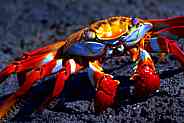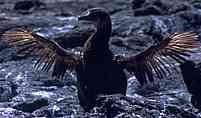
There are larger versions available for all of the images. To view
them, simply click on the images in this file.

There were a gazillion of these on the islands. The coloration varies
from island to island, and this is a shot of one of the more
spectacularly colored crabs on Fernandina Island. Sally Lightfoot was
apparently a very "entertaining" dancer from Guayaquil in the 19th
century.
1997 was a very wet year. Take a look at some of the photos below to see how much greenery there is in them. In 1994, things were pretty brown, which is the usual situation. An El Niño event is clearly occurring in 1997, so there's going to be a lot more rain and warmer water, so the sea life will get clobbered (lots of dead sea lions and birds that live on fish), and since the plants will do quite well, the birds that live on seeds and plants, like most of Darwin's finches, should do quite well.
Already the water was warm. In 1994, I froze my butt off every time I went in, and I had a wet-suit. Part of the problem was that in 1994 I had just finished running a marathon and my body fat was about as low as it's ever likely to get, and this year I was much better padded, but I do remember that on the previous trip, the instant I got in the water, the only thing I could think about was "How soon can I get out and not look like too much of a wimp?" In 1997, I was often in the water for an hour or more, sans wet-suit, with no problems at all.
Lava herons are found only in the Galápagos Islands. The adults
can be very dark and difficult to spot against the lava. This one is an
immature, and is a bit difficult to tell from the yellow-crowned night
heron baby which is also found on the islands.
I took the trip with a Stanford alumni group as part of a continuing education class, and before we left, we all took a course on evolution by professor Bill Durham of the Anthropology and Human Biology departments.
The trip was immeasurably enhanced by the fact that along with us stodgy old geezer alumni there were 11 undergraduates on the tour. It's amazing what they can do - party until 4 am and then be ready to land early the next morning. I'm pretty sure that we "overgrads" could out-drink them, however.
Blue footed boobies are extremely common on many of the islands. The image on the right makes it pretty clear where the name comes from. The booby on the left is standing on one of the ubiquitous trail markers. He's a male; you can tell because he has tiny pupils. Those males are always beady-eyed ...
On the other hand, beady-eyed though he is, he sure doesn't look very
intelligent. Where do you think the term "booby-hatch" comes from?
Here is a pair of masked boobies. The male is giving the female a twig
as part of the courtship ritual. It's probably an evolutionary
throwback because masked boobies don't make nests; they just lay eggs on
the ground.
If it's a bad year and there's not much food available, it may only be possible to raise one chick, and if more than one are born, the oldest is usually far more aggressive about obtaining food, and the younger chick will starve to death. In a good year, there may be enough food for both.
In good years, blue-footed boobies sometimes do raise two chicks, but
there is never more than one survivor in a masked booby nest. The older
chick actually forces the younger one out of the "nest", and once the
baby is outside, the parents refuse to recognize it as one of their own,
and it can't return and will starve. I put the word "nest" in
quotation marks because they just settle on a flat piece of ground, and
the edge of the nest is marked by a guano ring.

Among biologists, these are probably the most famous animals from the Galápagos Islands. Supposedly (see the section on mockingbirds below to see why I say "supposedly"), Darwin noticed that finches on different islands were different and concluded that they must have evolved to survive in the different conditions on different islands. They do vary enormously -- some have huge beaks for crushing giant seeds, some are brown and others are black, some are vegetarians, some use tools to dig grubs out of holes in plants, et cetera.
There are 13 or 14 species of finch, depending on how you count. The trouble is that there is so much variation within the species and so much interbreeding among them that it's impossible for anyone but an expert to tell them apart, and sometimes it's impossible for an expert, too.
I think the reason is that we've caught them in a state where speciation has not completely occurred. Many of the groups are only part-way to being completely different species. Unfortunately, taxonomic conventions force biologists to either put them in separate species or not. The particular species distinctions amoung some of the species are thus somewhat artificial, and it will always be a problem.
Well, not always. In a few million years, after speciation
occurs (or doesn't), it may be easier to tell.


The bird on the right is the Galápagos Mockingbird and the one on the left is called the Hood Mockingbird. There are four species of mockingbirds on the islands, and all are quite distinct. It is likely that Darwin first noticed the evidence that evolution had occurred with his mockingbird samples. They are much more clearly different species, and are fairly cleanly split with only one species per island.
The "Darwin Finches" are all jumbled up with large species overlaps, and with large taxonomic overlaps as well. Darwin even managed to get his own samples of the finches mixed up and mis-labelled as to what island they'd come from. He had to go to the Beagle's captain Fitzroy for help with ship's logs, et cetera, to try to sort out the finch mess after he got back to England.
But if you read Darwin's notes, there's evidence that the main ideas of evolution were starting to form after he left the islands, but before he got back to England where he could sort out the finch mess.
This was the coolest thing we saw this trip. The thumbnail image on the left is far too small to see what's going on, so click on it to get a decent-sized image.
The image shows a snake in the process of eating an immature marine iguana on the island of Fernandina. It looks like what happened is represented from top to bottom - the snake grabs the iguana by the head on the top, then begins to encircle it to crush it in the middle, and finally, it's completely crushing the iguana at the bottom.
Something like that probably happened, but the photos were in fact taken
in the opposite order. We came across the snake as in the bottom frame,
but I think that our presence frightened him (her?), so the snake
uncoiled so that the iguana could be dragged back into the rocks for a
more private meal.
On the left is a swallowtail gull. It's probably hard to tell from the thumbnail photo on the left, but the tongue has a huge hook in it. The gull was opening and closing it's mouth, but it was only open for an instant at a time, and I must have shot half of a roll of film to get one photo with the mouth open and the tongue exposed. Click on the thumbnail image to get a full-sized shot where you can actually see the tongue in detail.
On the right, of course, is another marine iguana, but this time with its tongue out. Where else could this photo go except next to the swallowtail gull?
It's not just swallowtail gulls that have strange tongues like this. I had a
bad experience on a bird-banding project in Ecuador because of the same
anatomical trait, but I was dealing with a tanager at the time. It
involved
biting.
One day from the boat we saw some wonderful little birds basically
dancing on the water. I guess they were fishing for some tiny fish,
but I never saw one catch anything. They simply flew right at the
surface of the water and dabbled their feet.

Since there were no major predators on the islands for millions of years, this cormorant has lost the ability to fly. This photo shows the pitiful condition of its wings. Like normal cormorants, they often spread their wings in the sun to dry them after a dive.
It is now much more seal-like; it is a very powerful swimmer, and has a very heavy, fat-coated body.
It's not a great photo because I couldn't get close -- it's taken with a 300 mm f/4 lens plus a 2x tele-extender for an effective 600mm f/8 lens. Thank goodness I had a tripod and a lot of light ...
And I thought I had the photo of the century with the "Iggy Boone" shot last time, where I managed to photograph a lava lizard on the head of a marine iguana.
We saw a lot of single Iggy Boones on this trip, but for one fleeting moment, there were two iggies on one boone, and I got the shot. I didn't even have to glue the iggies to the boone's head! Needless to say, I don't always get the shot.
Return to my home page for more links to photos
Tom Davis ( tomrdavis@earthlink.net)